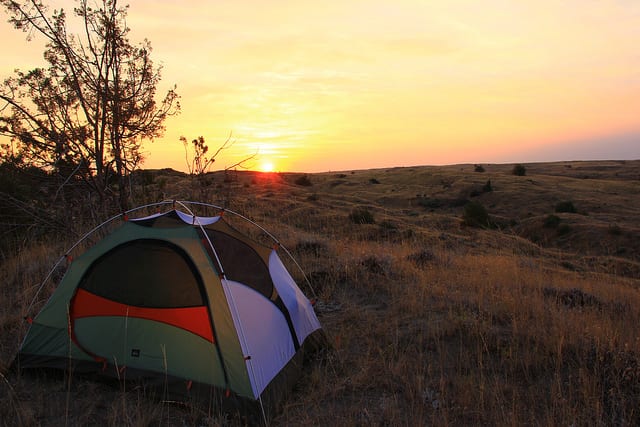Here at Postconsumers, we’ve talked about the eco-benefits of camping quite a bit in our Eco-Travel section of the site. And we certainly stand by our statements that camping is a great way to travel, relax and get some vacation enjoyment while also being (presumably) kind to the planet. However, much like many of the topics we’ve addressed in our “Hidden Consumerism” series, even things with strong intentions and sometimes strong good can be taken over with consumerism. Today, we’re giving a closer look at the hidden consumerism that can quickly infiltrate camping and its close cousins, outdoor activities.
The Most Obvious Camping Consumerism: The Gear, The Gear, The Gear
Again, we don’t want to imply that the only thing that you need to go camping is an old blanket and a pair of boots. You want to be both safe and comfortable when you’re out in nature. However, the question then becomes how much gear do you need? We talked about this topic in a related thread previously as it pertained to sports equipment and clutter. The slow-creep of consumerism into the world of camping is similar to that of sports. There’s gear that you really need for camping. And then there are some things that you want for camping that make the experience better. And then the consumer addiction to camping gear starts! You only need to visit an outdoor sports store once to see how quickly the escalation happens.
More and More Gear: Much like any other area where consumerism begins to creep in and take over, one of the only ways for companies to make money is to convince you that “real campers” have more gear. Before long you’re adding more lanterns, more stoves, more sleeping comforts, more tools … the list goes on and on. How do you counteract this? The answer is to always use the twenty-four hour rule. Wait twenty-four hours before you purchase anything and use that time to think about whether you really want or need it for camping enjoyment or practical reasons or whether you’re just in the gear spiral.
The Upgrade Game: If you’ve been around our site for a while, then you know that we also like to educate you on marketing tactics used in the consumer world. Last year we dedicated an article to educating you about the marketing traps associated with upgrade marketing. Our article on the topic focused primarily on technology upgrade marketing because that’s the most prevalent and easily understood example. However, this same marketing technique is used heavily in camping and outdoor activity gear as well. You have a tent, but do you have this upgraded tent with all of these extra features? You have a perfectly functional backpack, but wouldn’t this upgraded backpack with more pockets be better? How do you avoid upgrade marketing? Always stay grounded in whether the upgrade truly offers you a feature or features that you honestly need or that would honestly improve your experience or if you’re just falling prey to the enthusiasm of upgrade marketing tactics and coveting “more, more, more.” Sometimes you need an upgrade. Most of the time you do not!
Glamping: The Luxury Consumer Element of Camping
Over in our Eco-Travel and Ecotourism section, we’ve talked about glamping as a possible way for people who hate camping to actually love camping. And again, that is an assessment that we’ll happily stand by. However, don’t fool yourself into thinking that the very advent of luxury camping (“glamping” stands for “glamour camping”) isn’t largely about consumerism and marketing. It’s essentially a play on luxury marketing. There’s a belief that people will pay money for and purchase something simply because it’s considered a luxury good. It’s possible you’re reading that sentence and rolling your eyes, but the marketing research behind that concept backs up the idea. Glamping is simply an application of that theory to camping. We’ve talked before about how not all eco-travel is actually eco-friendly. While glamping is still more eco-friendly than other alternatives, it’s decidedly more consumerist than still other alternatives. We’re not saying that you shouldn’t go glamping or enjoy luxury camping. We’re simply hoping that you go into it understanding the marketing origin behind it.
The Rise of the Camping Super Store: All You Really Need to Know
At the end of the day, all you truly need to know in order to be sure is that big box stores have been built up around the idea of camping and outdoor activities. REI, Dick’s Sporting Goods and, of course, Cabella’s are all big box stores that cater to camping and outdoor enthusiasts. Where there is a big box store, there is the addictive consumerism to support the need for a big box store. Merchandise needs to be created to fill those big boxes and therefore consumer marketing needs to support generating the purchases to keep that train moving. Where there is a big box store, there is significant consumer infiltration. And that is certainly true in the camping and outdoor sector.
We love camping here at Postconsumers. Much of the staff here enjoys regular camping trips. However, camping isn’t immune from consumerism. Just make wise and educated decisions about how much commercialization you allow to creep into your camping and you’ll keep it both enjoyable and eco-friendly.
Have a different take on consumerism and camping? Tell us about it on the social media channels below.
Facebook | Twitter | Instagram | Tumblr | Pinterest | Google+ | Medium
Photo Credit: Bureau of Land Management Oregon and Washington via Flickr




